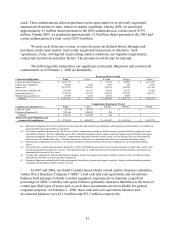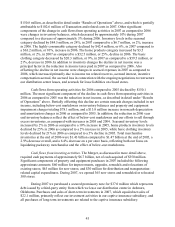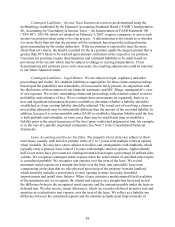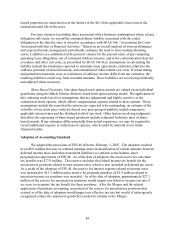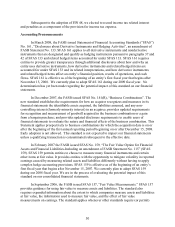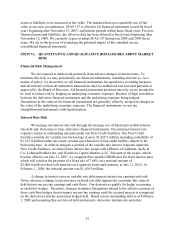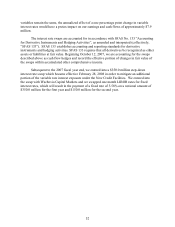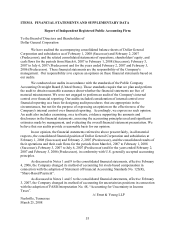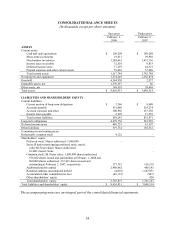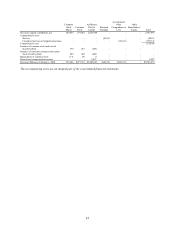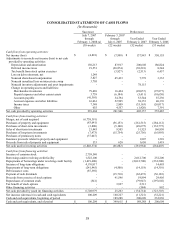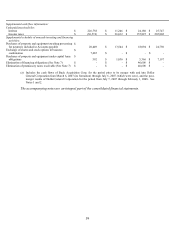Dollar General 2007 Annual Report Download - page 52
Download and view the complete annual report
Please find page 52 of the 2007 Dollar General annual report below. You can navigate through the pages in the report by either clicking on the pages listed below, or by using the keyword search tool below to find specific information within the annual report.50
Subsequent to the adoption of FIN 48, we elected to record income tax related interest
and penalties as a component of the provision for income tax expense.
Accounting Pronouncements
In March 2008, the FASB issued Statement of Financial Accounting Standards (“SFAS”)
No. 161, “Disclosures about Derivative Instruments and Hedging Activities”, an amendment of
FASB Statement No. 133. SFAS 161 applies to all derivative instruments and nonderivative
instruments that are designated and qualify as hedging instruments pursuant to paragraphs 37 and
42 of SFAS 133 and related hedged items accounted for under SFAS 133. SFAS 161 requires
entities to provide greater transparency through additional disclosures about how and why an
entity uses derivative instruments, how derivative instruments and related hedged items are
accounted for under SFAS 133 and its related interpretations, and how derivative instruments
and related hedged items affect an entity’ s financial position, results of operations, and cash
flows. SFAS 161 is effective as of the beginning of an entity’ s first fiscal year that begins after
November 15, 2008. We currently plan to adopt SFAS 161 during our 2009 fiscal year. No
determination has yet been made regarding the potential impact of this standard on our financial
statements.
In December 2007, the FASB issued SFAS No. 141(R), “Business Combinations”. The
new standard establishes the requirements for how an acquirer recognizes and measures in its
financial statements the identifiable assets acquired, the liabilities assumed, and any non-
controlling interest (formerly minority interest) in an acquiree; provides updated requirements
for recognition and measurement of goodwill acquired in the business combination or a gain
from a bargain purchase; and provides updated disclosure requirements to enable users of
financial statements to evaluate the nature and financial effects of the business combination. This
Statement applies prospectively to business combinations for which the acquisition date is on or
after the beginning of the first annual reporting period beginning on or after December 15, 2008.
Early adoption is not allowed. This standard is not expected to impact our financial statements
unless a qualifying transaction is consummated subsequent to the effective date.
In February 2007 the FASB issued SFAS No. 159, “The Fair Value Option for Financial
Assets and Financial Liabilities-Including an amendment of FASB Statement No. 115” (SFAS
159). SFAS 159 permits entities to choose to measure many financial instruments and certain
other items at fair value. It provides entities with the opportunity to mitigate volatility in reported
earnings caused by measuring related assets and liabilities differently without having to apply
complex hedge accounting provisions. SFAS 159 is effective as of the beginning of an entity’ s
first fiscal year that begins after November 15, 2007. We currently plan to adopt SFAS 159
during our 2008 fiscal year. We are in the process of evaluating the potential impact of this
standard on our consolidated financial statements.
In September 2006, the FASB issued SFAS 157, “Fair Value Measurements.” SFAS 157
provides guidance for using fair value to measure assets and liabilities. The standard also
requires expanded information about the extent to which companies measure assets and liabilities
at fair value, the information used to measure fair value, and the effect of fair value
measurements on earnings. The standard applies whenever other standards require (or permit)



